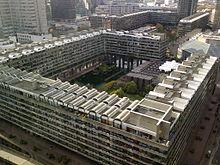Historical Evolution of London Architecture
London's architectural transformation spans thousands of years, reflecting changes in power, technology, and aesthetics. The city has seen a continuous layering of architectural styles, from the Roman-built London Wall to the medieval Tower of London and Westminster Abbey.
The Tudor period contributed timber-framed houses, while the 17th century saw Christopher Wren's churches, including St. Paul's Cathedral, revolutionizing London's skyline. The 18th and 19th centuries brought industrial advancements and architectural innovations like Victorian buildings and railway stations such as St. Pancras, showcasing gothic revival.
Residential architecture became more diverse, from terraced housing to grandiose mansions. The 20th century marked a shift towards Modernist perspectives, exemplified by the Battersea Power Station and the Barbican Estate. Postmodern structures like The Gherkin emerged in the early 21st century, signaling another chapter in London's architectural evolution.
Recent developments have focused on vertical limits, sustainability, and respecting broader social energies related to the environment, accessibility, and historical sensibilities. London's architectural panorama is a tireless overlaying of styles, visions, and regulations, persistently unraveling yet strongly venerable under global observation.

Iconic Post-War Buildings
In the aftermath of World War II, London faced the task of rebuilding its bomb-ravaged expanse. Among the most iconic post-war constructions is the Barbican Estate, a brutalist complex designed by Chamberlin, Powell and Bon1. Officially opened in the 1980s, the development includes:
- Tower blocks
- An arts centre
- Public spaces
The Barbican Estate signaled a new direction in urban living. Another crown jewel from this period is the Lloyd's Building, completed in 1986 based on designs by Richard Rogers. Known for its 'inside-out' design, the building showcases services like staircases, lifts, and pipes on its exterior, leaving an uncluttered space within2. Rogers' design drew from concepts of flexibility and transparency, expressing a hyper-modern push towards dynamic office environments.
These post-war edifices contribute to London's skyline, offering narratives of revival, resilience, and innovative spectacle. They stand as functional necessities and monumental achievements, altering London's architectural cadences into epochs of robust revivals.

Contemporary Architectural Marvels
Contemporary architectural edifices such as The Shard and The Gherkin symbolize London's push to the future, intertwining ambitious design with technological advancements. The Shard, designed by Renzo Piano, stands as a vertical cityscape, incorporating a mix of public and private spaces. It is the tallest building in London and manifests a bold foray into vertical urban planning.
The Gherkin, designed by Norman Foster, is notable for its energy-efficient design, symbolized by its aerodynamic form which promotes natural ventilation. Its complex tessellated facade of triangular glass panels is aesthetically profound and practically adept at modulating London's skyscape.
These contemporary titans merge sustainability with lofty aesthetic goals, serving utilitarian functionality while uplifting the sculptural aesthetics that elevate ordinary skyscrapers into oeuvres of public art. They contribute to London's standing on the global stage, pushing architects to imbibe futurism with functionality.

Architectural Diversity and Global Influence
London's architectural tapestry encapsulates an interplay between the old and the new, supporting its standing as an influential global city. The diversity ranges from Roman remnants to medieval intricacy, neoclassical grandeur, and industrial might.
As London transitioned into a modern capital, it juxtaposed new designs against its historical fabric, creating a palimpsest cityscape. This hybridization pushes into post-modern exemplifications, resonating across continents that gaze to London for inspiration.
London's capability to evolve, melding classic with futuristic design, provides a blueprint for metropolitan expansions worldwide.
Architecture schools and international firms frequently dissect elements from London's historic and contemporary makeup to accentuate or solve urban design complexities elsewhere. As London furthers its narrative, embellishing its landscape with newer amalgams, it invites global architects to re-think how cities can retain their soul amid ceaseless reinvention.
London serves as a living laboratory of experiential design contributions to the world stage, influencing architectural professions and impressing upon the communal audience an aesthetic consciousness.

London's architecture narrates a story of enduring adaptability and thoughtful progress. The city's ability to integrate iconic historical elements with groundbreaking modern designs continues to influence and inspire global architectural practices, making it a pivotal point of reference in the ongoing dialogue about urban development and cultural preservation.
- Harwood E. Chamberlin, Powell & Bon: The Barbican and Beyond. RIBA Publishing; 2012.
- Powell K. Lloyd's Building: Richard Rogers Partnership. Phaidon Press; 1994.
Leave a Reply